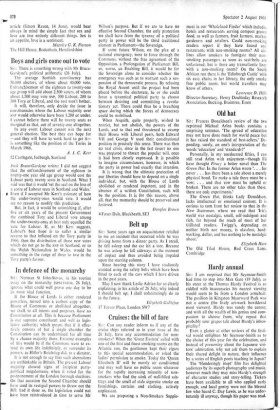Boys and girls come out to vote
Sir: There is something wrong with Mr Bruce- Gardyne's political arithmetic (26 July).
The average Scottish constituency has 50,000 electors, of whom about 40,000 vote. Enfranchisement of the eighteen to twenty-one age group will add about 2,500 voters, of whom about 1,500 may vote SNP, 300 Labour, 200 to 300 Tory or Liberal, and the rest won't bother.
It will, therefore, only decide the issue in constituencies where the Labour majority over sNe would otherwise have been 1,200 or under. I cannot believe there will be twenty seats as marginal as that, out of seventy-one altogether.
In any event Labour cannot win the next general election. The best they can hope for —and they will have to work hard to get it— is something like the position of the Tories in March 1966.
Jock Bruce-Gardyne writes: I did not suggest that the enfranchisement of the eighteen to twenty-one year old age group would cost the Labour party twenty seats in Scotland. What I said was that it would 'set the seal on the loss of a score of Labour seats in Scotland and Wales.' Even if I accepted Mr Kerr's estimate of how the under-twenty-ones would vote. I would see no reason to modify this prediction.
But, in fact, it would be astonishing if, after five or six years of the present Government the combined Tory and Liberal vote among the under-twenty-ones at best only equalled the vote for Labour. If, as Mr Kerr suggests, Labour's best hope is to suffer a similar reverse to that inflicted on the Tory party in 1966, then the distribution of those new votes which do not go to the SNP in Scotland, or to the Welsh Nationalists in Wales, would be something in the range of three to two in the Tory party's favour.






































 Previous page
Previous page